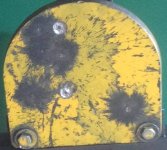Mosin-Marauder
New member
A bit shook up. But I felt I needed to make this post.
Was shooting my Mosin after school today at a steel gong using steel core surplus. I know this has worked for other people but I must be the unlucky one. First shot hit the gong with an authoritative thwack, and the core came right back over my head with a wizz. I unloaded the gun and walked over to see it cratered a big half inch stretch of the gong. I'm not going to be shooting steel core on steel targets anymore, for fear of more accurate steel cores. Just thought Id post this so no one else makes this mistake.I know I sound like a bit of a wuss, but it was kinda scary. Has this happened to anyone else? Anyway, thanks for reading.
Was shooting my Mosin after school today at a steel gong using steel core surplus. I know this has worked for other people but I must be the unlucky one. First shot hit the gong with an authoritative thwack, and the core came right back over my head with a wizz. I unloaded the gun and walked over to see it cratered a big half inch stretch of the gong. I'm not going to be shooting steel core on steel targets anymore, for fear of more accurate steel cores. Just thought Id post this so no one else makes this mistake.I know I sound like a bit of a wuss, but it was kinda scary. Has this happened to anyone else? Anyway, thanks for reading.

